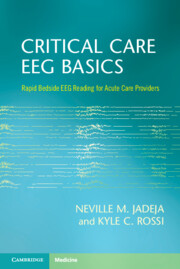Refine search
Actions for selected content:
35 results
Chapter 24 - Delirium Masquerading as Dementia
- from Section 3 - Treatment of the Dementias
-
-
- Book:
- The Behavioral Neurology of Dementia
- Published online:
- 17 November 2025
- Print publication:
- 11 December 2025, pp 399-412
-
- Chapter
- Export citation
Chapter 19 - Lesions and Encephalopathy
- from Part III - Specific Conditions
-
- Book:
- How to Read an EEG
- Published online:
- 27 September 2025
- Print publication:
- 24 July 2025, pp 284-303
-
- Chapter
- Export citation
Contrast-Induced Encephalopathy and the Blood-Brain Barrier
-
- Journal:
- Canadian Journal of Neurological Sciences / Volume 52 / Issue 1 / January 2025
- Published online by Cambridge University Press:
- 08 March 2024, pp. 85-94
-
- Article
-
- You have access
- Open access
- HTML
- Export citation
Chapter 14 - Encephalopathy
- from Part II - Case-Based Approach to Specific Conditions
-
- Book:
- Critical Care EEG Basics
- Published online:
- 22 February 2024
- Print publication:
- 29 February 2024, pp 191-203
-
- Chapter
- Export citation
Chapter 7 - Post–Cardiac Arrest EEG
- from Part I - Introduction
-
- Book:
- Critical Care EEG Basics
- Published online:
- 22 February 2024
- Print publication:
- 29 February 2024, pp 99-108
-
- Chapter
- Export citation

Critical Care EEG Basics
- Rapid Bedside EEG Reading for Acute Care Providers
-
- Published online:
- 22 February 2024
- Print publication:
- 29 February 2024
Chapter 5 - Coma, Delirium, and Dementia
- from Section 2 - Common Neurologic Presentations: A Symptom-Based Approach
-
-
- Book:
- Handbook of Emergency Neurology
- Published online:
- 10 January 2024
- Print publication:
- 17 August 2023, pp 51-69
-
- Chapter
- Export citation
Chapter 3 - The Neuropathology of Shaken Baby Syndrome or Retino-Dural Haemorrhage of Infancy
- from Section 2 - Medicine
-
-
- Book:
- Shaken Baby Syndrome
- Published online:
- 07 June 2023
- Print publication:
- 08 June 2023, pp 33-65
-
- Chapter
- Export citation
Neurological involvement in hospitalized children with SARS-CoV-2 infection: a multinational study
- Part of
-
- Journal:
- Canadian Journal of Neurological Sciences / Volume 51 / Issue 1 / January 2024
- Published online by Cambridge University Press:
- 04 January 2023, pp. 40-49
-
- Article
-
- You have access
- Open access
- HTML
- Export citation
Chapter 11 - Screening for Seizures in At-Risk Pediatric Patients
- from Part III - Practice of Neuromonitoring: Pediatric Intensive Care Unit
-
-
- Book:
- Neuromonitoring in Neonatal and Pediatric Critical Care
- Published online:
- 08 September 2022
- Print publication:
- 15 September 2022, pp 149-156
-
- Chapter
- Export citation
Case 2 - Neonatal Hypoxic-Ischemic Encephalopathy
- from Part V - Cases
-
-
- Book:
- Neuromonitoring in Neonatal and Pediatric Critical Care
- Published online:
- 08 September 2022
- Print publication:
- 15 September 2022, pp 208-210
-
- Chapter
- Export citation
Chapter 2.2 - Neuroborreliosis
- from 2 - Infectious and Postinfectious Vasculitis
-
-
- Book:
- Rare Causes of Stroke
- Published online:
- 06 October 2022
- Print publication:
- 01 September 2022, pp 112-118
-
- Chapter
- Export citation
Valproic acid-induced hyperammonemic encephalopathy: a clinical case
-
- Journal:
- European Psychiatry / Volume 65 / Issue S1 / June 2022
- Published online by Cambridge University Press:
- 01 September 2022, pp. S728-S729
-
- Article
-
- You have access
- Open access
- Export citation
Neuropsychiatric manifestations in a patient with prolonged COVID-19 encephalopathy: case report and literature review
-
- Journal:
- Irish Journal of Psychological Medicine / Volume 40 / Issue 3 / September 2023
- Published online by Cambridge University Press:
- 21 September 2021, pp. 487-490
- Print publication:
- September 2023
-
- Article
- Export citation
Encephalopathy caused by disulfiram
-
- Journal:
- European Psychiatry / Volume 64 / Issue S1 / April 2021
- Published online by Cambridge University Press:
- 13 August 2021, p. S707
-
- Article
-
- You have access
- Open access
- Export citation
Valproate induced encephalopathy: Paradigm of normal ammonia levels
-
- Journal:
- European Psychiatry / Volume 64 / Issue S1 / April 2021
- Published online by Cambridge University Press:
- 13 August 2021, p. S618
-
- Article
-
- You have access
- Open access
- Export citation
Chapter 23 - Global Dysfunction (Encephalopathy)
- from Part III - Specific Conditions
-
- Book:
- How to Read an EEG
- Published online:
- 24 June 2021
- Print publication:
- 15 July 2021, pp 219-229
-
- Chapter
- Export citation
Osmotic Demyelination Syndrome: A New Mime in the Circus of Neurology
-
- Journal:
- Canadian Journal of Neurological Sciences / Volume 49 / Issue 2 / March 2022
- Published online by Cambridge University Press:
- 13 April 2021, pp. 270-271
-
- Article
-
- You have access
- HTML
- Export citation
Neurological and Neuropsychiatric Impacts of COVID-19 Pandemic
-
- Journal:
- Canadian Journal of Neurological Sciences / Volume 48 / Issue 1 / January 2021
- Published online by Cambridge University Press:
- 05 August 2020, pp. 9-24
-
- Article
-
- You have access
- Open access
- HTML
- Export citation
DSM-IV mental disorders and neurological complications in children and adolescents with human immunodeficiency virus type 1 infection (HIV-1)
-
- Journal:
- European Psychiatry / Volume 19 / Issue 3 / May 2004
- Published online by Cambridge University Press:
- 16 April 2020, pp. 182-184
-
- Article
- Export citation
